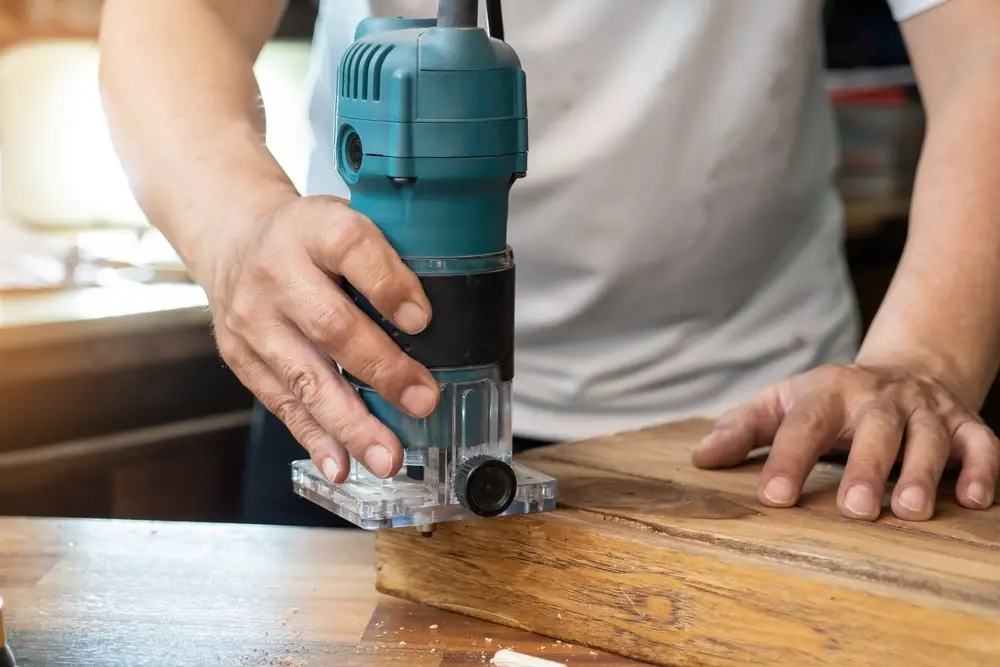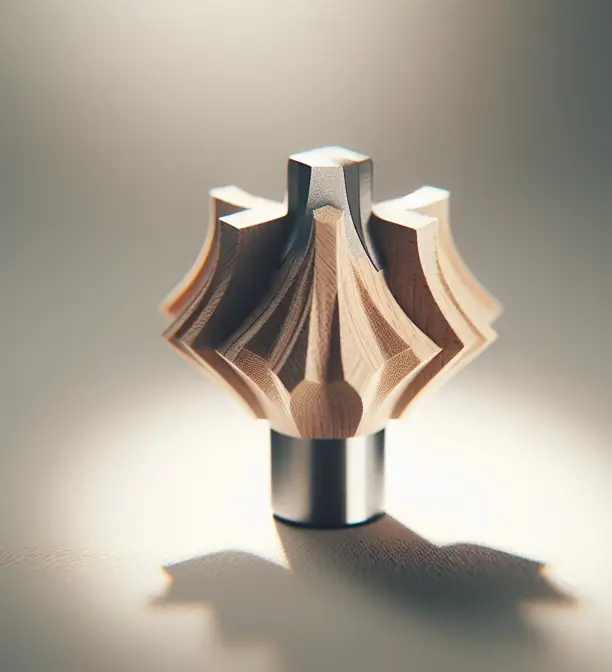Corded vs Cordless Router [Differences You Must Know!]
Wood routers are versatile power tools used for cutting various edges and shapes into woodworking pieces. They come in two main types – corded and cordless. While they serve the same primary functions, there are some key differences between corded and cordless routers that users should consider when deciding which type best suits their needs.
This comprehensive guide will examine the differences, pros, cons, uses, and other factors related to corded vs cordless wood routers. It aims to provide woodworkers, DIYers, and hobbyists the information needed to determine the right router option for their projects and workflow.

Key Differences Between Corded and Cordless Routers
Power and Runtime
The most significant difference between corded and cordless routers is the power source. Corded routers plug into an electrical outlet and provide consistent, uninterrupted power as long as the tool is plugged in. This makes them ideal for large, extended routing tasks where runtime is not a concern.
Cordless routers operate on rechargeable lithium-ion battery packs. Runtime is limited per charge, requiring batteries be charged when depleted. However, cordless routers provide greater portability and flexibility since there is no cord. Runtime varies based on battery capacity.
Torque and Speed Control
Corded routers generally offer more torque and fine speed control with electronic feedback circuitry. Variable speed options range from 8,000 to 30,000 RPM on high-end models. This wider, finely calibrated speed range allows optimal bit speed for different materials.
Cordless routers have preset speed settings, typically offering 2-3 options like 8,000/25,000 RPM or 12,000/28,000 RPM. Some advanced models have variable speed triggers for finer control. Overall, speed regulation is not as nuanced compared to corded routers.
Power and Precision
The direct power supply of corded routers allows them to maintain maximum torque and speed even under load. This results in better power and precision for heavy duty tasks like router table operations, jointing edges, and working with dense woods. Cordless routers can bog down and lose precision if pushed too hard.
Cordless router motors are smaller and optimized for portability. This generally makes them better suited for lighter duty freehand routing tasks. Though runtime is limited, cordless provides adequate power for most common routing applications.
Cost
Corded routers are generally less expensive than cordless. Prices for basic corded routers start around $50, while more heavy duty plunge routers run $150 to $300.
Cordless router kits cost $200 to $400. You pay for the convenience of cordless along with included batteries and charger. Bear in mind replacement batteries – a consumable item – are pricey.
| Feature | Corded Routers | Cordless Routers |
|---|---|---|
| Power Source | Electrical outlet; constant power. | Rechargeable batteries; limited runtime. |
| Runtime | Unlimited; ideal for long tasks. | Limited per charge; needs recharging. |
| Portability | Less portable; corded. | Highly portable; no cord. |
| Speed Control | Variable speeds (8,000-30,000 RPM). | Fewer speeds; some with variable triggers. |
| Power and Precision | Consistent power; better for heavy tasks. | Less power; suitable for lighter tasks. |
| Cost | $50 to $300; generally cheaper. | $200 to $400; more expensive. |
Pros of Corded Routers
Unlimited runtime: Corded routers provide continuous power as long as plugged into an outlet. No downtime waiting for batteries to charge.
Higher torque: More muscle for demanding tasks like jointing, edge forming, and router tables. Better maintains speed under load.
Finer speed control: Wider range of speed presets plus variable speed options on some models. Optimal bit speeds for different materials.
Lower cost: Corded routers are generally cheaper, especially for more powerful motors. Basic models under $100.
Proven durability: Time tested motor designs preferred by many professionals for withstanding daily use.
Precision: Consistent power delivery translates to excellent bit speed control and routing precision.
Cons of Corded Routers
Limited mobility: Cord length restricts how far you can move away from the power outlet. Can be hazardous if cord is in the way.
Noisiness: Corded routers tend to be louder since there is unlimited power. Fine for shop use but noisy for homes.
Learning curve: Variable speed settings take more experience to master appropriate speeds for different scenarios. Preset speeds are simpler.
Upgrade costs: Getting into advanced variable speed or soft start routers costs more. Basic models have limited features.
Pros of Cordless Routers
Untethered mobility: No cord allows for routing anywhere. Go where the work is without lugging cords.
Quieter operation: Less noise than corded makes cordless routers better suited for home DIY work.
Beginner friendly: Preset speeds simplify speed selection. Variable speed triggers on some models.
Compact size: Cordless router combos save space since one power unit runs different bases.
Safety: No dangling cord reduces tripping hazard. Easier to maintain control.
Quick start: Cordless routers turn on instantly with the press of a button. No dragging extension cords.
Cons of Cordless Routers
Limited runtime: Work sessions ultimately restricted by battery life, which varies based on capacity.
Reduced torque: Not ideal for extended heavy duty routing jobs. Can bog down more under load.
Replacement costs: Batteries wear down and need periodic replacement. Adds to long term cost.
Lower precision: Preset speeds are coarser so fine speed adjustments for bits are limited.
Heavier weight: Batteries and motor add weight, especially for fixed base routers. Increased fatigue.
Price: Cordless routers cost more – you pay for batteries and convenient portability.
Uses and Applications
Despite their differences, both corded and cordless router types are suitable for many common routing applications from job site use to home DIY projects.

Freehand Routing
Freehand routing involves guiding the router manually to cut edges and shapes. Control and ease of handling are key. Cordless routers excel at freehand tasks thanks to its detached mobility and quieter operation. Corded works but cord management is trickier.
Common freehand jobs include:
- Rounding over edges
- Chamfering edges
- Trimming laminates
- Mortising hinges
- Inlaying designs
Router Tables
Stationary router tables transform routers into shapers for advanced woodworking. Power and precision are vital here. Corded routers are preferred for router table use since they maintain torque and speed under load better. But cordless can work for lighter duty shaping tasks.
Typical router table operations include:
- Edge jointing
- Raised panel joinery
- Pattern arch cutting
- Grooving
- Dado cutting
Plunge Cutting
Plunge routers utilize bases that allow the bit to start inside the cut. This permits interior cuts not possible with fixed bases.
Both corded and cordless routers work for plunge cutting. Cordless offers more mobility between cuts, while corded provides continuous runtime for extended interior routing.
Plunge cutting is used for:
- Stopped grooves
- Recessing hinges
- Inset joinery
- Mortises
Laminate and Template Trimming
Trimming laminated countertops or following guide patterns requires smooth, controlled routing. These finesse applications favor cordless routers for their freehand maneuverability and quieter operation.
Sign and Decoration Making
Crafting decorative wooden signs, carvings, and emblems relies on precise freehand control. The handheld flexibility of cordless routers gives the best speed modulation for artistic cutting.
Factors to Consider
Here are some additional factors to weigh when choosing between corded and cordless wood routers:
- Projects: Consider what types of routing work you expect to take on most often. Precision-driven tasks like router tables favor corded, while handling-sensitive jobs like freehand trimming benefit cordless.
- Power needs: Think about the density and hardness of the wood species you’ll be routing. Harder woods like maple may demand the extra muscle of corded routers. Softer woods allow more leeway for cordless.
- Mobility needs: Assess if untethered movement is important for your workflow. Cordless wins for frequent mobility or remote use. Corded provides unlimited runtime in a fixed working area.
- Noise limitations: Corded routers generate more noise so cordless works better for home DIYers. Professional shops are less impacted by louder corded router noise.
- Cost considerations: Cordless requires paying a premium for portability. Corded gives you more power for the money.
Recommended Models
Here are some top recommended corded and cordless router options for common use cases:
Corded
Beginner/Light Duty: DeWalt DW616 Fixed Base Router – Excellent value under $100. Good for basic edging tasks.
All-Around Shop Model: Bosch 1617EVSPK – Sturdy 2.25 HP motor. Plunge and fixed bases included. Under $200.
Heavy Duty/Router Tables: Festool OF2200 – Smooth precision at a premium price. Unrivaled built quality for pros.
Cordless
DIY/Trim Use: Makita XTR01 – Compact kit with variable speed. Great handling for home projects.
General Purpose: DeWalt DWP611PK – Durable workhorse cordless combo kit. 1.25 HP suits most jobs.
High End: Festool TKC 1800BQ – Top notch 3.1 HP motor similar to corded. Superb but very pricey.
Conclusion
Corded and cordless routers each have their pros and cons and are suited for different routing scenarios.
Corded wins for extended runtime, maximum power and precision at the cost of mobility. Cordless offers untethered freedom of movement but with runtime limitations and less torque.
By evaluating their project needs and workflow, woodworkers can determine if a corded or cordless router better fits their requirements. One may suit a professional shop environment while the other appeals more to a DIY homeowner. Often, there are benefits to owning both types to cover a range of routing applications.

